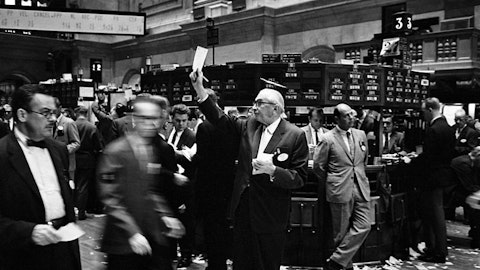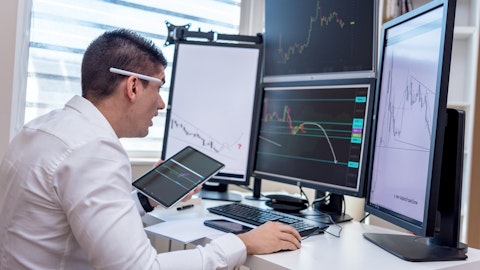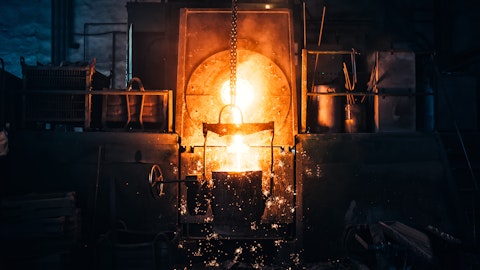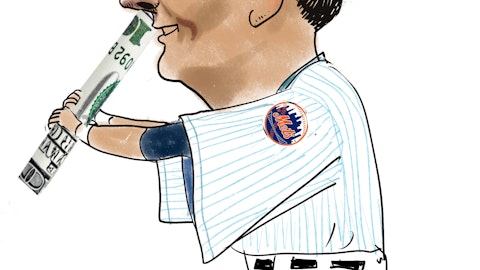Svein Moxnes Harfjeld: Thank you for sharing your views. So we are already building cash, but still being able to retain the 100% of net income as a dividend because the cash breakeven is, as Laila talked about for 2024, is $8,900 per day lower than the P&L breakeven, which is a threshold for dividends. So — and this is because depreciation is higher than amortization. So we are building cash without sort of having to be making smaller adjustments to the dividend. And I think there is some merit in having a very clear and well-defined dividend policy that people understand that this fixed percentage of net income, it will allow the investors, although we are in a market where earnings vary, it’s very clear what they will get out of the business without impairing the balance sheet of the company or reducing our ability really to be able to invest. So we are committed to the current policy, and that is what you should expect going forward.
Robert Silvera: Okay. Well, for me, from my — our standpoint, it’s kind of an optics thing. If you look at 2022, your cash and cash equivalents at the end of the year were $125 — $126 million. At the end of this year, you’re down to $75 million, approximately. So overall, year-over-year, your cash is dropping. I…
Svein Moxnes Harfjeld: No, that’s — excuse me for interrupting you for a moment there, but — you have to — you’re forgetting that we made an investment last summer in a five year old ship of $94.5 million. And we did this without issuing any new equity and that was cash reserves that were built up despite paying out 100% of net income, and that was accretive to earnings immediately for all the shareholders. So that’s where the sort of difference in cash position is reflected.
Robert Silvera: Okay. I accept that.
Svein Moxnes Harfjeld: Thank you.
Robert Silvera: The other thing that troubles us is you had, a couple of years ago, pledged you were going to aggressively lower debt. And I remember the days when you were around $900 million. And of course, you are down considerably to that now to $354 million in debt, but it’s up from 2022 where it was $271 million. We would just like to see you come off optically I’m saying, as if this business has a very long-term future that’s going to grow and significantly reward as you have in the past. Don’t get me wrong. I think you guys have done a great job, and we’re very happy as shareholders for years now. But it’s an optical thing. And apparently, the shipowners, in general, they’re not placing orders for new tankers. So the industry seems to be looking at it — at its future as if, well, oil is going to disappear.
And I think we both agree that that’s real, that’s not realistic at all. So we would just like to see you continue on that path of significantly pointing out the reduction of debt and the idea of keeping — like I said, keeping a little bit back, not more than 10% of what you could pay as a dividend according to the way you’re going now. And this shows that we see the future brightly, and we’re reserving cash, we’re strengthening our balance sheet even more rapidly than the rate in which you’re doing it now. That’s where we’re coming from, and it’s an optics thing. We’re very happy, and we thank you very much, Svein and [indiscernible] doing such a great job.
Svein Moxnes Harfjeld: Thank you very much for your kind words. We appreciate you sharing your thoughts with us. Thank you.
Robert Silvera: God bless you.
Operator: Thank you. We’ll now take our next question. This is from the line of Omar Nokta from Jefferies. Please go ahead.
Omar Nokta: Hi, thank you. Hi, Svein. Just wanted to put myself back in the queue. I had maybe two more follow ups. Just one back to — sorry to bring it back to the Red Sea. I did want to ask, because you mentioned that it hasn’t been much of an impact for VLCCs. But just in general, is there — do you think there’s maybe perhaps like a backdoor way that VLCCs benefit from this just in terms of Suezmaxes and Aframaxes that would normally be competing against the LCCs in, say, the Middle East market? Those are now diverting and thus not as able to compete going forward. Is that something or is there just not enough of a competition from them in the first place for it to really matter?
Svein Moxnes Harfjeld: I think if the situation stays on for a good while, that will happen. So in the short term, of course, people are sort of scrambling just to fix the immediate problem and getting the oil delivered as quickly as they can. But the cost of bringing sort of Suezmax and not talking about an Aframax around South Africa to avoid the canal compared to doing a big ship is significant. So if this stays on for a little while longer, then people will increasingly move those barrels into bigger ships, we think. So you’re right in your sort of, I guess, loaded question that VLCCs will stand to benefit from this, if this carries on for a while.
Omar Nokta: Okay. Thank you. And then just one quick one on the fleet sort of acquisitions and that type of thing. The — clearly, the fleet you mentioned is aging rapidly. There’s not a lot of capacity coming on until ’27. Asset values have risen materially and I know it makes it difficult to get deals done, although the one you mentioned last year was — looked like a good price at a good time. What do you think about going older in this environment? Does it make sense to look out for ships in that 10-plus year range, going down a bit on the age range, perhaps getting a better ROE potential in this market?
Svein Moxnes Harfjeld: Yeah. Of course, you employ less cash on all the ships, obviously. There is a meaningful earnings differential between the ships that were built after ’15 given the eco designs and there are sort of older siblings. So you need to sort of reflect that into your investment calculation. I think there are a number of customers that will have to be more dynamic in looking at age of ships. Operating costs are a bit higher. So a lot of details here, not just a sort of a headline number and do a quick one on the 12 seats. So we are, of course, running numbers on everything, but I think it’s important that we do get good fuel economics in all the ships, also relates to sort of CII trajectory, it relates to access to time charters in due course if that wants to — if that’s something we want to have in the portfolio.
So it’s not sort of a simple fix to do that. But of course, we keep a keen eye on all these things. And if the dislocation is bigger than it is now, maybe you have to look at that. But I don’t think it’s sufficient to justify going older versus going younger, although the nominal number is higher on the younger end.
Omar Nokta: Got it. Understood. Fine. Thank you. That’s very clear. I’ll turn it over.
Svein Moxnes Harfjeld: Okay. Thank you, Omar.
Operator: Thank you. We’ll now take our next question. Please stand by. Next question is from the line of Stefano Grasso from 8VantEdge. Please go ahead.
Stefano Grasso: Hello, hi, Svein and team. Congratulations on the quarter. Just to follow up on the capital allocation. It looks like we’re going to have two, three years with no deliveries and the supply/demand tightening up as we go along. Of course, we can’t predict what — who is going to order what, but let’s say that at some point, some vessels are going to be ordered, it will still take like two, three years at the minimum for these deliveries to have an impact and kind of rebalance the market [Technical Difficulty] cycle, that’s probably out six-plus years. Is that plausible for DHT to basically do nothing for six-plus year, kind of get the cash flow from the fleet and wait for that bust further out to happen and then in the typical style of DHT, take advantage of that market and get longer gain vessels?
Svein Moxnes Harfjeld: Yeah. It’s a good question. Of course, it’s possible, but it will sort of involve having a different strategic take on how to run the business because today, our fleet is just shy of 10 years, about 10 years old on average. And if you look six years out, it becomes 16 and the company will shrink quite meaningfully and we might be debt-free, but we will have much less ability to do things than what we do today. So I think if a strategy like that at all were to be contemplated, it would be more sort of running the business out in totality and pay out all the money and then close shop at some point. But that is not in the cards. So — and we believe it will be possible to do things, to invest for the company and do good things for the company.
And we have our sort of eyes on that. So hopefully, we can uncover the right opportunity and put that to bed and continue to develop the company. So I think it’s a bit in our current format and strategy, it’s unrealistic. And I think some of our key customers will also potentially not be as supportive as they are today. So…
Stefano Grasso: Yeah. Thank you.
Svein Moxnes Harfjeld: Thank you.
Operator: Thank you. [Operator Instructions] There are no further questions at this time. I will hand back to the speakers for any closing remarks. Thank you.
Svein Moxnes Harfjeld: Well, thank you very much to all for listening in on DHT’s quarterly earnings call, much appreciated, and wishing you all a good day ahead.
Operator: Thank you. This does conclude the conference for today. Thank you for participating, and you may now disconnect. Speakers, please stand by.





